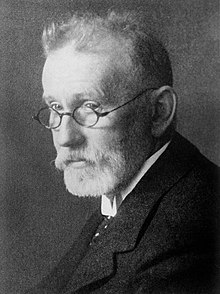Paul Ehrlich
| Paul Ehrlich | |
|---|---|
 |
|
| Born |
14 March 1854 Strehlen, Lower Silesia, German Kingdom of Prussia |
| Died |
20 August 1915 (aged 61) Bad Homburg, Hesse, Germany |
| Citizenship | German |
| Fields | Immunology |
| Notable students | Hans Schlossberger |
| Known for | Chemotherapy, Immunology |
| Notable awards | Nobel Prize in Physiology or Medicine (1908) |
| Spouse | Hedwig Pinkus (1864–1948) (m. 1883; 2 children) |
| Children | Stephanie and Marianne |
| Signature | |
Paul Ehrlich (German: [ˈeːɐlɪç]; 14 March 1854 – 20 August 1915) was a German physician and scientist who worked in the fields of hematology, immunology, and antimicrobial chemotherapy. He invented the precursor technique to Gram staining bacteria. The methods he developed for staining tissue made it possible to distinguish between different types of blood cells, which led to the capability to diagnose numerous blood diseases.
His laboratory discovered arsphenamine (Salvarsan), the first effective medicinal treatment for syphilis, thereby initiating and also naming the concept of chemotherapy. Ehrlich popularized the concept of a magic bullet. He also made a decisive contribution to the development of an antiserum to combat diphtheria and conceived a method for standardizing therapeutic serums.
In 1908, he received the Nobel Prize in Physiology or Medicine for his contributions to immunology. He was the founder and first director of what is now known as the Paul Ehrlich Institute.
Born 14 March 1854 in Strehlen in Silesia in what is now south-west Poland.
Paul Ehrlich was the second child of Rosa (Weigert) and Ismar Ehrlich. His father was an innkeeper and distiller of liqueurs and the royal lottery collector in Strehelen, a town of some 5,000 inhabitants in the province of Lower Silesia, now in Poland. His grandfather, Heymann Ehrlich, had been a fairly successful distiller and tavern manager. Ismar Ehrlich was the leader of the local Jewish community.
...
Wikipedia
